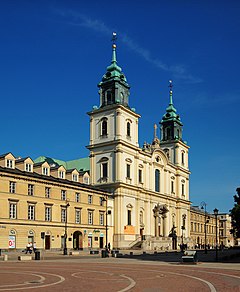Holy Cross Church, Warsaw
| Holy Cross Church Kościół św. Krzyża (Polish) |
|
|---|---|

Church façade (center), 2010.
|
|
| General information | |
| Architectural style | Baroque |
| Town or city | Warsaw |
| Country | Poland |
| Construction started | 1682 |
| Completed | 1757 |
| Demolished | 1944 |
| Client | Michał Stefan Radziejowski |
| Design and construction | |
| Architect | Józef Fontana |
The Church of the Holy Cross (Polish: Bazylika Świętego Krzyża) is a Roman Catholic house of worship in Warsaw, Poland. Located on Krakowskie Przedmieście opposite the main Warsaw University campus, it is one of the most notable Baroque churches in Poland's capital.
The Holy Cross Church is currently administered by the Missionary Friars of Vincent de Paul.
As early as the 15th century, a small wooden chapel of the Holy Cross had been erected here. In 1526 the chapel was demolished, and a newer church was erected. Refurbished and extended by Paweł Zembrzuski in 1615, the church was too small to fill the needs of the growing city. Initially located well outside the city limits, by the 17th century it had become one of the main churches in the southern suburb (przedmieście) of the city that had in 1596 become Poland's capital.
In 1653 Queen Marie Louise Gonzaga gave the church to the French order of Missionary Friars of Vincent de Paul. However, three years later Warsaw was captured by Swedish armies during the Deluge. Pillaged, the church was found to be damaged beyond repair. During the reign of King John III Sobieski the church's remnants were demolished, and it was decided to erect a new shrine. In the 18th century this became the origin of the gorzkie żale tradition.
The main building was constructed between 1679 and 1696. Its main designer was Józef Szymon Bellotti, the royal architect at the Royal Court of Poland. It was financed by abbot Kazimierz Szczuka and the Primate of Poland Michał Stefan Radziejowski. The façade was relatively modest and reminded of Renaissance facades of the nearby churches. The two towers surrounding the façade were initially square-cut. Between 1725 and 1737 two late Baroque headpieces by Józef Fontana. The façade itself was refurbished by Fontana's son, Jakub (in 1756) and ornamented with sculptures by Jan Jerzy Plersch.
...
Wikipedia
